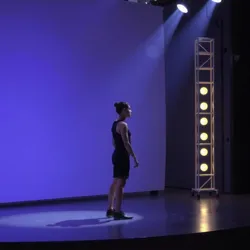Transhumanism in Performing Arts

Transhumanism in Performing Arts is an emerging field that explores the integration of advanced technologies and transhumanist ideas into theatrical and performance art. By incorporating elements such as artificial intelligence, biotechnology, and virtual reality, artists are redefining the boundaries of live performance and audience interaction.
Origins and Development
The concept of transhumanism in performing arts gained traction in the early 21st century, as advancements in technology began to offer new possibilities for artistic expression. Pioneers in this field sought to explore the implications of human enhancement and the merging of organic and synthetic forms in a theatrical context. Productions like Singularity Dreams have been instrumental in bringing these ideas to the forefront, challenging traditional narratives and encouraging audiences to question the future of humanity.
Key Themes
Transhumanism in performing arts often focuses on themes such as identity, consciousness, and the ethical considerations of technological advancement. These themes are explored through innovative storytelling techniques and immersive experiences that engage audiences on multiple sensory levels. Performances may include elements like AI-driven characters, interactive digital environments, and augmented reality components, creating a unique blend of the physical and virtual worlds.
Ethical Considerations
One of the central themes in transhumanist performances is the ethical implications of human enhancement and the use of technology to transcend biological limitations. Artists often use their work to provoke discussions about the potential consequences of such advancements, exploring both the utopian and dystopian possibilities of a technologically enhanced future.
Notable Productions
Several productions have gained recognition for their exploration of transhumanist themes in the arts:
- Singularity Dreams: This play, starring Marla Viridian, delves into the relationship between human consciousness and artificial intelligence, using cutting-edge technology to enhance storytelling.
- The Resonance of Time: A performance that explores temporal perception through a narrative structure that evolves with audience interaction, reflecting the fluidity of time in a transhumanist context.
- The Harmonious Craft: A theatrical experience that examines the intersection of art, technology, and craftsmanship, pushing the boundaries of traditional performance.
Impact on the Arts
The integration of transhumanist ideas into performing arts has had a significant impact on the industry. It has inspired a new generation of artists to experiment with technology, leading to the development of hybrid art forms that blend live performance with digital media. This movement has also sparked academic interest, with scholars examining the implications of these innovations on cultural and societal norms.
Future Directions
As technology continues to evolve, the possibilities for transhumanism in performing arts are virtually limitless. Future directions may include the use of biotechnology to enhance performers' physical abilities, the incorporation of neural interfaces for direct audience engagement, and the development of fully immersive virtual reality experiences that blur the line between performer and spectator.
See Also
- Quantum Stageworks: Discover how this company is pioneering advancements in theatrical technology.
- The Harmonious Craft: Explore the intersection of performance, technology, and craftsmanship.
- The Resonance of Time: Learn about this innovative performance exploring temporal perception.
References
- Interview with Marla Viridian on her role in Singularity Dreams.
- Article on Quantum Stageworks and their contributions to modern theater.
- Analysis of ethical themes in transhumanist performances by Philosophy and Arts Review.